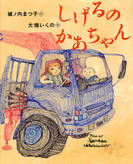
Shigeru no Kachan (Shigeru’s Mom)
Written by Matsuko Jyonouchi
Illustrated by Ikuno Ohata
Iwasaki Shoten, Japan, 2012, n.p.
ISBN: 978-4265081165
The cover of Shigeru no Kachan (Shigeru’s Mom) shows a small boy beside a young woman who has dyed-brown hair and wears mascara over false eyelashes. Who are they? The boy is Shigeru, a first-grade student, and the woman is his mother—a single Japanese woman working as a truck driver. Shigeru is proud of his mother because he believes that she can do things that seem difficult for women. For example, when a typhoon demolishes a kennel, she fixes it with just a screwdriver. In another example, she leads a group in extinguishing a fire that threatens to destroy a food store—a modern hero for all intents and purposes. In a poignant image depicting the strong bond between mother and son, Shigeru returns home from school with his mother in her truck one afternoon. He proudly announces, “My mom is cool.” Shigeru’s friends respond with, “Shigeru’s mom is a dud! She is cool, though.” Their words imply compliment and admiration towards Shigeru’s mother that acknowledge her strength of character.
Ikuno Ohata’s colorful and dynamic watercolor illustrations enable readers to experience this strength. Readers may also metaphorically experience the energy and courage of Shigeru’s mother through her abilities in truck driving and, even at one point, grass cutting that she handles masterfully. The expressive faces of characters portray a range of emotions from fearful to joyous, while the vivid and detailed illustrations of characters and landscapes gracefully contribute to the story by allowing the reader to picture themes of hope, courage, and the bonds of a single-parent family.
This realistic fictional story reflects current changes in the Japanese public’s awareness of multiple family lifestyles. Since the 1990s, there have been a growing number of single-parent families due to a significant rise in the number of divorced and unmarried mothers in Japan. Somewhat previously concealed in society, single mothers have become more visible through various media. Children’s literature is one medium through which the topic has been dealt, giving voice to these marginalized women. Furthermore, Shigeru’s Mom presents a single mother’s self-sufficiency through the prowess of various employments, such as a truck driver. This trend has continued with the publication of recent Japanese children’s books that show the shrinking of gender disparity regarding access to jobs. For example, My Mom is a Train Conductor (2012) by Yasuo Otomo, is a story about a mother working as a train conductor. Additionally, Shigeru’s Mom highlights another cultural aspect of Japanese single mothers–over 80 percent hold down jobs, far exceeding the majority of other industrialized countries (Fujiwara, 2008). Women who become homemakers following childbirth are generally seen as having limited work experience; therefore, offered salaries are low. Consequently, this low-income factor causes single mothers, who wish to work, to choose extraordinary jobs. They have limited employment opportunities, so physical or blue-collar work has become the only route to make money. Shigeru’s truck-driving mother is an example.
Published in 2012, Shigeru’s Mom won the 2013 Japan Picture Book award that was founded in 1978 by the Yomiuri Shinbun (a Japanese national newspaper company) and the Japan School Library Association to disseminate picture book arts, promote reading, and contribute to the development of children’s books. This is the first picture book published in Japan by the author, Matsuko Jyonouchi, while Ikuno Ohata is an illustrator of children’s literature having studied oil painting at Western Wyoming Community College in the U.S.
As yet, Shigeru’s Mom has not been made available in English, but future translation could be paired with works that pick up on the values, traditions, and diversities of family lifestyles. I Live in Tokyo (2001), the story of a two-generation family living in Tokyo by Mari Takabayashi, is one such example. Additionally, The Way We Do It in Japan (2002) by Geneva Cobb Lijima and Paige Billin-Frye presents the story of a Japanese-American bicultural family set in Japan. Books that offer characters who explore their identity, such as Tea with Milk (1999) by Allen Say and Hiromi’s Hands (2007) by Lynne Barasch, are further connections. Ruby’s Wish (2002) by Shirin Yim and Sophie Blackall explores a Chinese girl’s struggle with gender inequality in China, while Sing to the Dawn (1996), a novel by Minfong Ho in which a young village girl from Thailand seeks a place for female, also offer numerous possibilities for discussion on gender and identity.
Junko Sakoi, University of Arizona, Tucson, AZ
WOW Review, Volume VI, Issue 2 by Worlds of Words is licensed under a Creative Commons Attribution-NonCommercial-ShareAlike 4.0 International License. Based on work at https://wowlit.org/on-line-publications/review/vi-2/
Fujiwara, C. (2008). Single mothers and welfare restructuring in Japan: Gender and class dimensions of income and employment. Asia-Pacific Journal: Japan Focus. http://japanfocus.org/-Fujiwara-Chisa/2623. Accessed October 11, 2013.
